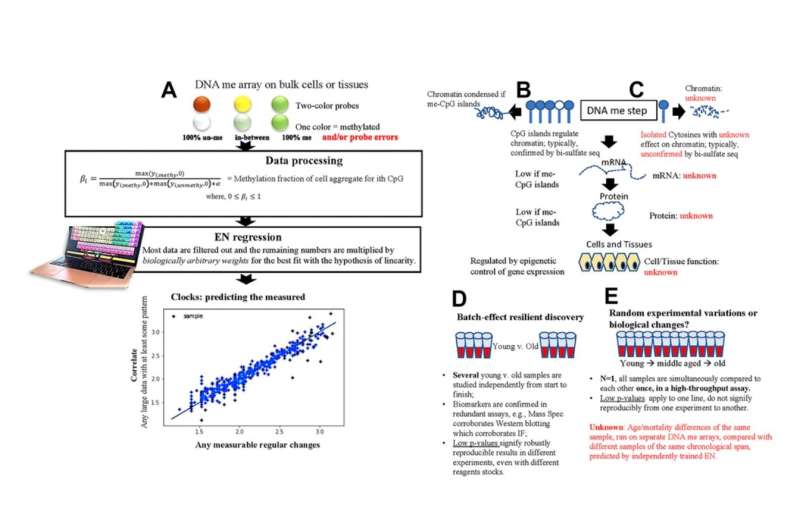This article has been reviewed according to Science X's editorial process and policies. Editors have highlighted the following attributes while ensuring the content's credibility:
fact-checked
proofread
Development of a noise barometer for measuring epigenetic pressure of aging and disease

A new paper titled "Fail-tests of DNA methylation clocks, and development of a noise barometer for measuring epigenetic pressure of aging and disease" has been published in Aging.
In this new study, researchers Xiaoyue Mei, Joshua Blanchard, Connor Luellen, Michael J. Conboy, and Irina M. Conboy from the University of California, Berkeley, show that Elastic Net (EN) DNA methylation (DNAme) clocks have low accuracy of predictions for individuals of the same age and a low resolution between healthy and disease cohorts, caveats inherent in applying linear model to non-linear processes.
"We found that change in methylation of cytosines with age is, interestingly, not the determinant for their selection into the clocks," write the researchers.
Moreover, an EN clock's selected cytosines change when non-clock cytosines are removed from the training data, as expected from optimization in a machine learning (ML) context, but inconsistently with the identification of health markers in a biological context.
To address these limitations, the researchers moved from predictions to measurement of biological age, focusing on the cytosines that on average remain invariable in their methylation through lifespan, postulated to be homeostatically vital. They established that dysregulation of such cytosines, measured as the sums of standard deviations of their methylation values, quantifies biological noise, which in their hypothesis is a biomarker of aging and disease.
"We term this approach a 'noise barometer'—the pressure of aging and disease on an organism," they explain.
These noise-detecting cytosines are particularly important as sums of SD on the entire 450K DNAme array data yield a random pattern through chronology. Testing how many cytosines of the 450K arrays become noisier with age, the team found that the paradigm of DNAme noise as a biomarker of aging and disease remarkably manifests in approximately one-fourth of the total. In that large set even the cytosines that have on average constant methylation through age show increased SDs and can be used as noise detectors of the barometer.
More information: Xiaoyue Mei et al, Fail-tests of DNA methylation clocks, and development of a noise barometer for measuring epigenetic pressure of aging and disease, Aging (2023). DOI: 10.18632/aging.205046



















